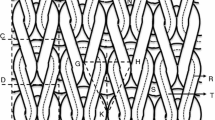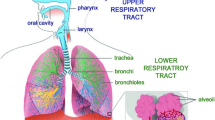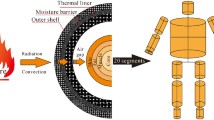Abstract
Protective clothing is used in many industries to protect firefighters and other workers from fire and other hazards. While skin burns can occur during a fire, protective fabric temperatures remain high for some time even after a fire ends. Therefore, skin burn injuries can occur during the time in which a fabric is cooling. A heat transfer model has been developed that can predict inherently flame resistant fabric temperatures and skin burn injuries during this cooling phase. This paper describes the heat transfer model, including methods used to calculate the apparent heat capacity and the convection heat transfer coefficient as the fabric cools. The new model has been validated using data from bench top tests of Kevlar®/PBI fabric specimens. Parametric studies using the model demonstrate the importance of selected thermal properties and boundary conditions on fabric temperatures and bench top test results.
Similar content being viewed by others
References
ASTMF1930-00: Standard Test Method for Evaluation of Flame Resistant Clothing for Protection Against Flash Fire Simulations Using an Instrumented Manikin, West Conshohocken, PA: American Society for Testing and Materials, 2000.
ASTMD 4108-87: Standard Test Method for Thermal Protective Performance of Materials for Clothing By Open-Flame Method, West Conshohocken, PA: American Society for Testing and Materials, 1987.
NFPA 1971: Standard on Protective Ensemble For Structural Fire Fighting, Quincy, MA: National Fire Protection Association, 2000.
D.A. Torvi and J.D. Dale, “Heat Transfer in Thin Fibrous Materials Under High Heat Flux,” Fire Technology, vol. 35, 1999, pp. 210–231.
D.A. Torvi and J.D. Dale, “Numerical Models for Use in the Design of Protective Clothing for Firefighters,” Journal of Industrial Textiles, vol. 29, 2000, pp. 273–286.
C.M. Sawcyn and D.A. Torvi, “Flow Visualization in Air Spaces Between Protective Fabrics and Sensors in Protective Clothing Tests,” in Proceedings of 13th International Symposium on Transport Phenomena (ISTP13), Victoria, BC, 2002, pp. 197–202.
C.M. Sawcyn, “Heat Transfer Model of Horizontal Air Gaps in Bench Top Testing of Thermal Protective Fabrics,” M.Sc. Thesis, University of Saskatchewan, Saskatoon, SK, 2003.
S.D. Williams and D.M. Curry, “Thermal Protection Materials: Thermophysical Property Data,” National Aeronautics and Space Administration, Scientific and Technical Information Program, Washington, DC, NASA Reference Publication 1289, 1992.
H.L. Morse, J.G. Thompson, and K.J. Clark, “Analysis of the Thermal Response of Protective Fabrics,” Acurex Corporation, Aerotherm Division Report AFML-TR-873-17, 1973.
J.P. Holman, Heat Transfer, 6th edition, New York: McGraw-Hill, 1986.
D.A. Torvi, “Heat Transfer in Thin Fibrous Materials Under High Heat Flux Conditions,” Ph.D. Dissertation, University of Alberta, Edmonton, AB, 1997.
F.C. Henriques Jr., “Studies in Thermal Injuries V. The Predictability and the Significance of Thermally Induced Rate Processes Leading to Irreversible Epidermal Injury,” Archives of Pathology, vol. 43, 1947, pp. 489–502.
Author information
Authors and Affiliations
Corresponding author
Rights and permissions
About this article
Cite this article
Torvi, D.A., Eng., P. & Threlfall, T.G. Heat Transfer Model of Flame Resistant Fabrics During Cooling After Exposure to Fire. Fire Technol 42, 27–48 (2006). https://doi.org/10.1007/s10694-005-3733-8
Published:
Issue Date:
DOI: https://doi.org/10.1007/s10694-005-3733-8




